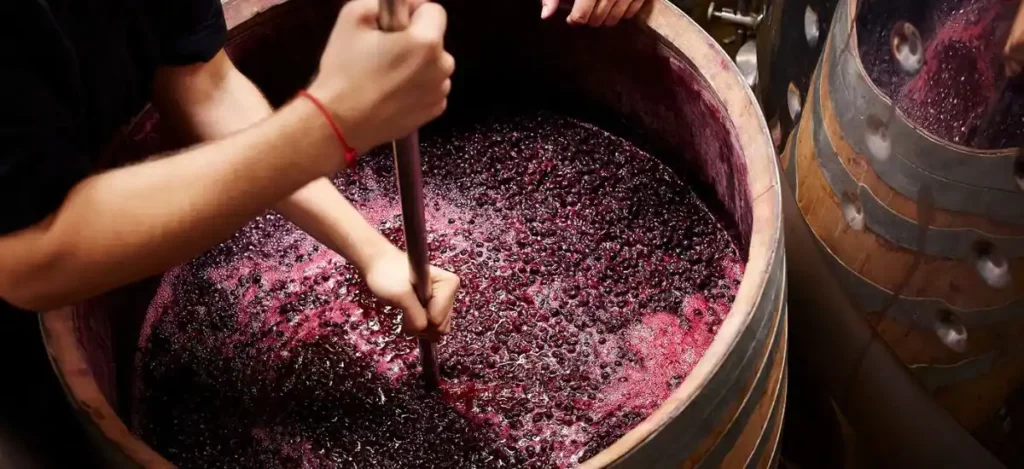Making wine at home is very simple just mix yeast and grape juice together, put that mixture in a shady place, and then allow the fermentation process to do the rest.
But though this process sounds like a piece of cake, you need to be extra careful throughout the entire procedure – starting from choosing the right grapes to the end of the fermentation process. Always remember that only an artistic nature of a person can extract the best flavors of wines.
If you are making wine at your home, then it will seem like a test of your patience, because this is the most important thing in winemaking. Winemaking is way different from distilling whisky or brewing beer. You need to have a great knowledge of the ingredients as well as have to be perfect in timing!
So, let’s now start!
What You Need To Make Wine
To make wine, you will need 60-75 pounds of grapes, a large carboy, a funnel, an airlock, wine yeast, a heavy-duty colander, an enormous container, and a long stick for stirring purposes.
Steps To Make Your Own Wine

The process I am about to give you below will help you to make five gallons of wine in total, or you can say 25 bottles containing 750 ml of grape wine in each. The budget for this venture will be approx. $400 for the grapes, and some basic tools that you can buy from any online store or local wine or brewing market.
First of all, carefully read all the steps written below, then try how to make wine at home.
Step 1 - Arrange the Grapes
Try to get the best quality grapes from the market. The quality of grapes will decide the quality of the wine you will make. Arrange approx. 60-75 pounds of grapes.
Yes, you can buy these grapes from any online store or winemaking shop, but the best thing will be if you buy these grapes from any vineyard. If you buy grapes from vineyards, they will charge you $1 or $2 for every pound of grapes.
Try not to use grape concentrate. This can make your wine sweeter or less sweet than the requirement. You can use wine grape juice including grape skins, they are as good as fresh.
Step 2 - Crush-Press-Stomp
First of all, you have to press or crush the grapes to bring out the juice from the grapes. But if you already have pre-crushed must or grape juice, then you can skip this part. But if you do not have those, then you have to undergo this process.
After getting the grape juice, you have to stomp them by your feet. Then you can dump these grapes in a big container. Make sure that the container is clean. Next, clean your feet very well with soap and water, and then start stepping on the bunches of grapes.
Keep pressing them until those grape bunches are smashed. Only then the juice will release.
If you want to make white wine, then just ferment the grape juice after this step. Pour the juice in bulk into a glass carboy through a funnel.
After this, press the leftover grape stems and skins into a pot using a heavy-duty colander and collect the rest of the juice.
If you are making red wine, ferment the whole grape skins, juice, and seeds once you finish plucking out all the stems.
Step 3(I) - For White Wine
You have to start with 5.25 gallons of white grape juice to get at least 5 gallons of white wine. Next, you have to pour all the juice into a closeable container or a carboy. Remember that the size of the container must be larger than the volume of the juice.
You will see the grape juice turning golden or green at first, and soon it will turn brown when they are pressed and started fermenting. As the fermentation goes on, the juice will turn pale gold or yellow.
Do not forget to use an airlock so that you can keep the oxygen out, because only then the carbon dioxide produced by the process of fermentation will escape.
Now you have to add wine yeast. Remember to read the instructions printed on the packet. Keep the temperature of the room comfortable where you have kept the juice.
You will see a light carbon dioxide foam emission within a day or two. This is the signal that will indicate that the fermentation process has started.
Keep removing the stopper once every day and stir the lees settling down at the bottom as well as the juice. If you see the foam coming out of the vessel, just mop that up and slightly cool the container.
Step 3(II) - For Red Wine
In the case of red wine, these must not really require an airlock or tightened top at the time of fermentation. You can ferment it even in a large container using just a thin piece of plywood or towel to keep the fruit flies and dust off.
Just add some wine yeast to the must following a gentle stir. The fermentation process can start within 12 hours.
In the case of red wine, you have to keep stirring the mixture twice per day. Keep submerging back the cap of the skins regularly right into the wine that you will see floating at the top to keep them wet. This will extract the key flavor and color compounds from those skins.
Keep the temperature at 80 degrees Fahrenheit.
Step 4 - The Fermentation Magic
You have to keep testing the sugar level of the juice from time to time using a hydrometer with a graduated cylinder.
If you are making white wine, the fermentation process can last for weeks depending on the temperature. A warmer room shortens the time. And red wine fermentation, provided a warm temperature, can last for one or two weeks.
Separate the newly made wine from the gross lees of the fermentation process. Keep the wine in a 5-gallon carboy in order to allow it to be matured.
To siphon off the juice for white wine, using tubing is ideal. Next, put the container above two feet of the carboy, and use your mouth to start the flow.
Pour the juice into a carboy and press those skins to extract any remaining juice for red wines. Put this extracted juice into the carboy as well. Tight the top using an airlock.
Step 5 - Protect The Wine
To protect the wine, keep the top always tightened and try to open it as fewer times as you can.
Recipes For Making Wine At Home
- Arrange grapes.
- Crush the grapes to extract the juice.
- Add wine yeast to start fermentation.
- Wait until the fermentation finishes.
- Protect the wine.
Frequently Asked Questions
1. Is it worth making your own wine?
Yes, of course! Homemade wines can taste as good as those commercial products!
2. Is it legal to make wine at home in the US?
For adults, it is legal to make wine at home in the US for personal and family usage.
3. Can homemade wine be alcoholic?
Fermentation is the key process for making wine, and this process itself produces up to 20% alcohol. Thus, homemade wine can be alcoholic.
The Final Words
Here in this article, I have given the entire process of how to make wine at home. I hope now you can make wine at your home after reading this article. All the best!
Check More Posts :


